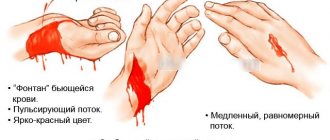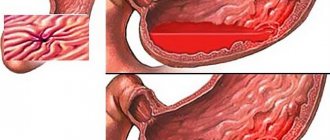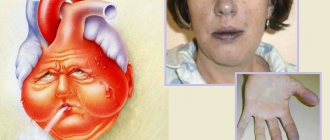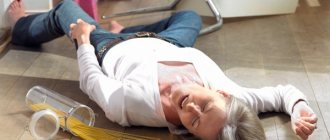Why do you need first aid for bleeding?
Emergency care for bleeding is a set of immediate preventive and therapeutic actions in a situation where any of the blood vessels (capillary, venous or arterial) are damaged. First aid is carried out while waiting for the arrival of specialists until the victim is hospitalized.
In total, approximately 5 liters of blood circulate in the adult human body. Losing more than 30% of this amount is risky for life, especially if this happens in a short time.
Depending on the location, blood loss can be external and internal, and depending on the type of damaged vessel - capillary, arterial and venous. First aid for bleeding involves following certain rules and performing certain actions, and for each type they are different.
Help with damage to an arterial vessel
When bleeding from an artery, a pulsating discharge of bright scarlet blood is observed. This condition is the most dangerous, since in a short time a person experiences severe blood loss, which sometimes causes death. In such a situation, you need to immediately begin taking steps to stop the bleeding.
If the artery is damaged and bleeding begins, you need to act as follows:
- Press your thumb on the vessel above the damage - this is required to stop or weaken the flow.
- Place a rubber tourniquet or other suitable object at hand (for example, wire, rope, belt, etc.) on the damaged vessel above the wound, this will help reduce blood loss.
- Be sure to leave a piece of paper indicating the exact time when the tourniquet was applied.
- Bandage the injured area.
- When first aid to the victim is completed, he must be immediately transported to the emergency room or any nearest medical facility.
It should be noted that the tourniquet must be removed a maximum of 2 hours after it is applied. Otherwise, the tissue begins to die.
Most common reasons
Often the cause is bruises or closed-type injuries under the influence of a certain external factor. Thus, effusion into the pleural niche occurs due to injury to the lung, rib fractures, and damage to the integrity of the vessels located between the ribs. Medical assistance may also be needed for pulmonary hemorrhage caused by tuberculosis or progression of cancer.
The described pathology develops with a closed lesion of the pancreas, kidneys or liver, spleen, or any area of the intestine. The most dangerous in medicine is considered to be profuse bleeding, which is a complication of gastrointestinal diseases, in particular:
- Erosive gastritis.
- Varicose veins affecting the veins in the esophagus.
- Malignant formations.
- Peptic ulcer, etc.
Internal bleeding, which requires first aid, can be caused by an ectopic pregnancy, damage or torsion of the ovaries, or rupture of a cyst.
First aid for venous bleeding
In comparison with bleeding from an artery, when a vein is injured, a discharge of blood of a darker shade is observed, and in such a situation it is not pulsating. Although, if large venous vessels are affected, bleeding is also fraught with negative consequences. If there is no timely help, death may occur.
To stop bleeding from a vein, you need to do the following:
- Raise the injured limb upward.
- Apply a pressure bandage to the damaged area - this is necessary to compress the soft walls of the injured vessel. If the blood loss is significant, a tourniquet is applied above the wound.
- Call an ambulance to transport the victim to a medical facility.
When providing first aid for bleeding from a vein, you should not do the following:
- do not try to wash the injured area or remove small objects that have fallen into it (for example, pebbles, glass);
- Do not touch blood clots with your hands - this may cause blood to flow again.
Specialized care: stopping bleeding
Immediately after hospitalization, diagnostic measures are carried out. Based on their results, the doctor makes a conclusion about the severity of the pathological process.
If the blood loss is minor, in most cases the body can cope with it. To help the defense mechanisms, doctors administer medications to the victim.
Prescribed drugs for internal bleeding:
- Fibrinolysis inhibitors. Examples of agents: “Aminocaproic acid”, “Aprotinin”, “Thrombin”.
- "Etamzilat." Necessary for improving microcirculation.
- Synthetic analogues of vitamin K.
These are the main ways to stop internal bleeding as part of specialized care. But only if a small amount of liquid connective tissue is lost.
Capillary bleeding
This type of bleeding often goes away on its own. It is characterized by slow penetration of blood over the entire surface of the wound. Although in some cases there is a serious injury, which is accompanied by large loss of blood. The most risky is bleeding from the capillaries in the internal organs.
The main sources of capillary leakage are:
- Hematological diseases accompanied by impaired blood clotting ability.
- All kinds of injuries.
- Vascular pathologies in the form of neoplasms, purulent inflammation of the skin, in which the capillaries are affected.
- The presence of common diseases that affect the vascular walls (tumors, atherosclerosis, rheumatoid arthritis).
- Hormonal imbalance.
As a rule, capillary blood loss does not release much blood. It is dangerous because pathogenic microorganisms can enter the wound.
If the capillary is damaged, proceed as follows:
- Elevating your injured arm or leg slightly above heart level will help reduce blood loss.
- If the injured area is small, treat the skin near the wound with an antiseptic. Apply a bactericidal patch on top.
- In case of serious bleeding, a pressure bandage is applied.
- When blood loss is very severe, bend your arm or leg as far as possible above the wound. If there is no effect, use a tourniquet.
- Place something cold on the injured area - this will help stop the flow of blood and ease the pain.
It is strictly forbidden to touch the wound with your hands (even clean ones), as there is a possibility of infection.
Nose bleed
Nosebleeds can develop due to certain reasons, for example, due to the weakness of the vascular walls in the nasal mucosa. With this problem, a person may bleed from the nose even after vigorously blowing his nose or sneezing.
Bleeding from the sinuses is quite common in people who suffer from high blood pressure. Also caused by changes in atmospheric pressure. And the most common source of such bleeding is trauma to the nose.
To provide first aid for nosebleeds, proceed as follows:
- Place a cotton wool turunda in your nasal sinuses and tilt your head slightly forward.
- Apply something cold to the bridge of the nose - this promotes vasoconstriction, resulting in less blood loss.
- If the bleeding has not stopped after 15 minutes, contact an ambulance.
When helping a victim with a nosebleed, you should follow some rules:
- don't throw your head back. Because of this, blood enters the respiratory or digestive organs:
- When the bleeding has stopped, it is forbidden to blow your nose for a while, as this contributes to the re-development of bleeding. You will have to stop eating hot foods and drinking for some time, as this promotes vasodilation.
MedGlav.com
Bleeding can occur not only from injury, but also from disease and blunt trauma.
Nose bleed. Nosebleeds can sometimes be significant and require emergency treatment. The causes of nosebleeds are varied. Bleeding occurs as a result of local changes (trauma, scratching, ulcers of the nasal septum, with strong nose blowing, skull fractures), and as a result of various diseases: blood diseases, heart defects, infectious diseases (scarlet fever, influenza, etc.), hypertension . When a nosebleed occurs, blood flows not only out through the nasal openings, but also into the pharynx and oral cavity. This causes coughing and often vomiting. The patient becomes restless, which increases bleeding.
The person providing assistance must first eliminate all causes that increase bleeding. It is necessary to reassure the patient, convince him that sudden movements, coughing, talking, blowing his nose, and straining increase bleeding. The patient should be seated, given a position in which there is less opportunity for blood to enter the nasopharynx, an ice pack, a ball of snow wrapped in a scarf, a handkerchief moistened with cold water, a bandage, a ball of cotton wool, etc. should be placed on the area of the nose and bridge of the nose. it is necessary to ensure a sufficient supply of fresh air; if bleeding occurs from overheating, move the patient to the shade, apply cold compresses to the head and chest.
If the bleeding does not stop, you can try to stop it by firmly pressing both halves of the nose to the nasal septum. In this case, the patient’s head is tilted slightly forward and possibly higher, and the nose is squeezed with force. The patient must breathe through his mouth. You need to squeeze your nose for 3-5 minutes or more. The patient should spit out blood that gets into the mouth.
Instead of pressing, you can tamponade the nasal passages with a dry ball of cotton wool or a ball of cotton wool moistened with a solution of hydrogen peroxide. Cotton balls are inserted into the nasal passages, and the patient's head is tilted forward. On cotton wool, the blood clots quite quickly and the bleeding stops. Usually, these measures will stop the bleeding; otherwise, the patient must be immediately taken to the hospital.
Bleeding after tooth extraction. Significant bleeding may occur after tooth extraction. It is stopped by filling the defect in the gum with a ball of cotton wool and pressing it tightly with the teeth.
Bleeding due to damage to the ear canal and internal structures of the ear (impact, scratches, fracture of the skull). It is stopped by inserting gauze into the external auditory canal, folded into a funnel, which is held in place with a gauze bandage over the ear.
Pulmonary hemorrhage. If the lungs are damaged (a strong blow to the chest, broken ribs), or a number of diseases of the lungs and heart (tuberculosis, cancer, lung abscess, mitral heart disease, etc.), pulmonary hemorrhage may develop. A patient with sputum and coughing begins to secrete scarlet foamy blood - hemoptysis. Sometimes pulmonary bleeding is very severe.
If blood appears in the sputum of the patient, it is necessary to free him from clothes that impede breathing and immediately place him in a semi-sitting position. If possible, the patient should be reassured and convinced that he needs complete rest for treatment. There should be a lot of fresh air in the room where the patient is. The patient is prohibited from moving, talking, and is advised to breathe deeply and hold back his cough. It is advisable to place an ice pack on your chest. Anti-cough tablets are prescribed as medications.
Any pulmonary bleeding is a terrible symptom of any serious illness, so the task of first aid is to quickly deliver the patient to a medical facility. Patients with pulmonary hemorrhage are overly sensitive to transportation. Delivery of such patients from home to a medical facility should be carried out by special ambulance transport in a semi-sitting position, and special care must be taken to avoid shaking and sudden movements, which can increase coughing and bleeding.
Bleeding into the chest cavity. With a blow to the chest, broken ribs, and some lung diseases, blood vessels can be damaged and one or both pleural cavities can fill with blood. The accumulating blood compresses the lung, causing breathing problems. Due to blood loss and exclusion of the lung from the act of breathing, the patient’s condition quickly deteriorates: breathing becomes more frequent and becomes difficult, the skin becomes pale, with a bluish tint.
The patient must be urgently transported to a medical facility. Help consists of giving the patient a semi-sitting position. An ice pack is applied to the chest.
Gastrointestinal bleeding. Bleeding into the cavity of the stomach and intestines is a complication of a number of diseases (peptic ulcer, stomach cancer, varicose veins of the esophagus, etc.) and injuries (foreign body, burn, etc.). It can be significant and lead to death. Symptoms of gastric bleeding, along with the general symptoms of acute anemia (pallor, weakness, sweating), are bloody vomiting or vomiting contents the color of coffee grounds, frequent loose stools and black stool (tarry stool).
To improve the patient's condition and reduce bleeding, it is necessary to create rest for the patient, give him a horizontal position, put an ice pack on his stomach, and completely prohibit the intake of food and liquid.
The main task of first aid is to organize the immediate delivery of the patient to a medical facility. Patients with gastrointestinal bleeding should be transported in a supine position with the leg end of the stretcher raised - this prevents bleeding of the brain.
Bleeding into the abdominal cavity. Occurs with blunt trauma to the abdomen, most often due to ruptures of the liver and spleen. The cause of intra-abdominal bleeding may be some diseases of the liver and spleen; In women, bleeding is possible as a result of a rupture of the fallopian tube during an ectopic pregnancy.
Bleeding into the abdominal cavity is manifested by severe abdominal pain. The skin is pale, the pulse is frequent. If there is significant bleeding, loss of consciousness may occur. The patient should be laid down, an ice pack should be placed on the stomach, and food and water intake is prohibited. Such patients should be immediately transported to the hospital in the supine position.
Acute anemia. Develops with significant blood loss. Patients tolerate blood loss in different ways. Children and the elderly are most sensitive to blood loss. People who have been ill for a long time, hungry, tired, or in a state of fear do not tolerate blood loss well.
An adult may hardly feel the loss of 300-400 ml of blood at all, but for a child this blood loss will be fatal. Instant blood loss (2-2.5 liters) is fatal.
The loss of 1-1.5 liters of blood is very dangerous and is manifested by the development of a severe picture of acute anemia, expressed by a sharp circulatory disorder and the development of oxygen starvation. A similar condition can develop with relatively small blood loss, but it occurs very quickly. The severity of the patient’s condition is judged not only by the amount of blood shed, but also by the level of blood pressure.
Symptoms of acute anemia are very characteristic and do not depend on whether the patient has external or internal bleeding. The patient complains of increasing weakness, dizziness, tinnitus, darkening and flickering of spots in the eyes, thirst, nausea, and vomiting. The skin and visible mucous membranes become pale, facial features become sharper. The patient is inhibited, sometimes, on the contrary, excited, breathing is rapid, the pulse is weak or not detected at all, blood pressure is low. Subsequently, as a result of blood loss, loss of consciousness may occur due to bleeding of the brain, the pulse disappears, blood pressure cannot be determined, convulsions appear, and involuntary separation of feces and urine. If appropriate measures are not taken urgently, death occurs.
With large blood loss and low blood pressure, bleeding may stop; however, when providing first aid, it is necessary to apply a pressure bandage to the wound, and then begin anti-shock measures. The victim should be laid on a flat surface to prevent anemia of the brain. In case of significant blood loss that causes fainting or shock, the patient (wounded) is placed in a position in which the head is lower than the body. In some cases, it is useful to perform a “self-blood transfusion”: all the limbs of a lying wounded person are raised, thereby achieving a temporary increase in the amount of circulating blood in the lungs, brain, kidneys and other vital organs. If consciousness is preserved and there is no damage to the abdominal organs, the patient can be given hot tea, mineral water or, if it is not available, plain water.
In terminal conditions and cardiac arrest, resuscitation is performed. The main method of treating acute anemia is an urgent transfusion of donor blood, so the victim must be taken to a medical facility as quickly as possible. When transported by a special ambulance, blood transfusion can be performed in the car, since such vehicles have a supply of donor blood.
Stomach bleeding
The main reasons for the formation of gastric blood loss are pathologies of the digestive organs and other diseases. These include the presence of:
- peptic ulcer in the stomach and duodenum;
- gastric diverticulum;
- oncology in this organ;
- benign tumors in the stomach or polyps;
- erosive formations on the gastric mucosa or erosive gastritis.
In addition, some medications that irritate the gastric mucosa can provoke gastric bleeding. These include acetylsalicylic acid, drugs from the NSAID group, etc. You can also encounter a similar problem with frequent stress or after surgery.
Symptoms
Internal bleeding, including gastric bleeding, is characterized by the following symptoms:
- severe weakness, even to the point of fainting;
- pale skin, blue skin on fingers, nose, lips;
- cold sweat;
- noise effect in the ears, flickering before the eyes;
- nausea;
- vomiting mixed with coagulated blood;
- pain in the stomach area;
- feces acquire a characteristic black tarry hue.
First aid for stomach bleeding
If signs of bleeding in the stomach are detected, emergency medical care must be provided to the victim. While waiting for an ambulance, you need to act as follows:
- Lay the victim on his back on a hard surface.
- If vomiting occurs, you need to turn his head to the side to prevent vomit from entering the respiratory tract.
- Place something cold on the peritoneal area (ice or a bottle filled with chilled liquid). Monitor your temperature to prevent frostbite.
- Monitor the victim's blood pressure. If blood pressure drops to 100 mm Hg. Art. and less, the bleeding began to transition to a more serious stage.
When providing first aid for gastric bleeding, some requirements should be observed:
- do not move the patient, create calm conditions for him and remain in a lying position on a solid horizontal plane;
- It is important to give up food and drink for a while; if you are thirsty, you can put a piece of ice in your mouth.
First aid for stomach bleeding. First aid for intestinal bleeding
Stomach, intestinal or gastrointestinal bleeding is a condition in which, due to damage or destruction of the vascular wall of the digestive organ, blood enters the cavity of the esophagus, stomach, or part of the intestine.
Gastrointestinal bleeding is a very dangerous condition.
The severity of the victim’s condition is determined by the following factors:
- degree of damage to the vascular wall of the organ
- intensity of bleeding
- blood pressure level
- state of the blood coagulation system
The causes of this internal bleeding
- erosive and ulcerative diseases of the gastrointestinal tract
- varicose veins of the esophagus
- benign and malignant formations of the stomach and intestines
- prolonged vomiting, due to which blood vessels in the stomach or esophagus burst
- injury
- foreign body in the stomach
Symptoms of bleeding in the stomach or intestines include paleness, nausea, indigestion, red or black streaked stool, vomiting blood, and abdominal pain.
IMPORTANT: If you suspect gastrointestinal bleeding, you must call an ambulance.
You need to do the following yourself:
- lay the victim down, create peace for him
- Elevate the patient's legs at an angle of 15 degrees
- put cold on your stomach
IMPORTANT: In a patient with gastrointestinal bleeding, breathing and heartbeat may stop, so these functions need to be monitored. The patient should not be left alone. He should not be given food or drink.
Internal bleeding
The cause of this phenomenon can be a disease or injury to any internal organ. This condition is very dangerous, because blood loss cannot be controlled. In addition, with such bleeding there is no pain, which can serve as a signal of a problem. As a result, the presence of internal bleeding may not be noticed for a very long time. And the victim will pay attention to this only after a sharp deterioration in health.
The most risky is the flow of blood in the parenchymal system, which often lacks a cavity and has a well-formed structure of veins and arteries. These include the lungs, liver and pancreas.
Injury to any of these systems can cause serious bleeding. Such blood loss itself almost never stops, since the vessels here are located in the tissue and are prone to compression. For this reason, in case of bleeding in the parenchymal system, it is necessary to provide the patient with emergency assistance. In addition to injury, the development of such blood loss can be triggered by the presence of tuberculosis, decay or rupture of a neoplasm.
Symptoms
Internal bleeding is characterized by the gradual development of the following symptoms:
- lethargy;
- feeling unwell;
- dizziness;
- fainting;
- apathy;
- drowsiness;
- lowering blood pressure;
- pale skin;
- increased pulsation.
First aid for internal bleeding
The main goal of assistance with bleeding in internal organs is to urgently hospitalize the victim. While waiting for an ambulance, you need to do the following:
- Lay the patient down and keep him calm.
- Apply something cold to the abdomen or sternum, this is due to the location of the likely source of the problem.
- You can use hemostatic medications (Aminocaproic acid, Vikasol).
If the pressure drops sharply during parenchymal bleeding, raise the victim’s legs above the level of the heart by approximately 30-40 cm. Constantly monitor respiratory and cardiac functions.
If necessary, resuscitation measures are carried out. In this condition, the patient is contraindicated in taking painkillers and any other medications. Eating and drinking are also prohibited; you can only rinse your mouth with water.
If first aid is provided quickly and correctly for any type of bleeding, the prognosis will be favorable. Prompt provision of assistance also contributes to a quick recovery of the victim.
Internal damage
Internal bleeding is the most dangerous type of injury, since it is difficult to recognize immediately, and therefore there may not be time to help the victim.
Signs of internal bleeding are not always clearly expressed, so secondary symptoms have to be taken into account:
- Severe weakness;
- Chills, increased cold sweat;
- Dizziness, which may result in loss of consciousness;
- Impaired functioning of the respiratory system;
- The abdomen becomes hard, the patient curls up into a ball.
First aid for internal bleeding consists of the following:
- Immediately call medical professionals;
- Cold on the stomach.
You need to pay attention to what you absolutely cannot do in case of internal damage:
- Do not give the victim anything to drink or eat;
- Any medications are prohibited until the PMP arrives.
In this case, with emergency care, it is important to do no harm.
With postpartum hemorrhage, there is a danger of infectious complications, so if there is severe bleeding from the vagina, you should immediately consult a doctor.
Before the patient is examined by doctors, she must be placed on a flat surface with her legs slightly elevated. You can use cold in the abdominal area, but you should not take a bath or other procedures associated with elevated temperatures. It is important to drink as much fluid as possible.
Other damage
Injuries and bruises are not always accompanied by blood loss. However, they can cause serious consequences for human health, including internal bleeding and concussions.
First aid for bruises consists of recognizing the cause and location of the injury. If it is not strong, simply provide the victim with rest until the doctors arrive. In case of bleeding, confusion, or suspected internal bleeding, trauma care is provided according to the above recommendations.
Attention!
If bloody discharge from the ear begins, the patient requires urgent hospitalization, regardless of the reasons that caused it.
First aid for bleeding from the ear consists of the following:
- Sit the patient so that the head tilt allows the blood to flow freely;
- A bandage is placed on the ear so that the auricle remains open;
- If a foreign object gets into your ear, you cannot remove it yourself;
- For severe bleeding, apply ice to the bandage;
- Wait for medical workers to arrive.
How to apply a pressure bandage correctly
If a vein is damaged and there is constant bleeding from the wounded area, you should not try to wash it and remove any glass, sand, or pebbles that have gotten into the wound with your own hands.
If the damaged surface of the skin is very dirty, you can quickly treat the area around the wound, for example, use a damp cloth (without touching the edges of the wound, moving outward) and treat with an antiseptic.
When the preparatory phase is completed, apply a pressure bandage:
- A sterile napkin or other clean material soaked in an antiseptic is applied to the wound.
- The napkin must be secured by making 3 turns with a bandage around the injured limb.
- Next, you should apply a strong fabric or cotton roller, which will apply pressure to the wounded area. Then the roller needs to be bandaged, making several circular rounds.
- If the bandage becomes soaked in blood, do not remove it. A new bandage is simply applied on top.
- For maximum results, elevate the injured limb.
Removing blood clots and blood clots is prohibited - this can lead to severe blood loss.
When a pressure bandage has been applied on your own, the victim must be transported to a medical facility to receive specialized care.
How to apply a tourniquet correctly
A tourniquet is used to stop bleeding from an artery or when a limb is amputated due to injury. In other conditions, it is pointless to use the device, since this method of stopping blood can severely injure the skin and soft tissues. To temporarily stop blood loss, you can use an Esmarch tourniquet or a handy rubber material.
To apply a tourniquet correctly, you must follow some rules:
- If possible, the limb should be slightly raised for a short time and secured in a comfortable position - this will facilitate the outflow of blood in the veins.
- The tourniquet should be applied to clothing or by placing a piece of cloth over it - this will help protect the skin.
- Make the first two turns as tight as possible; they help stop the blood. The tourniquet should be crossed on the opposite side of the injured vessel.
- You can hold a tourniquet on a limb in summer for no more than 1.5 hours, and in winter for a maximum of 1 hour. If it is not possible to transport the patient to a medical facility during this time period, release the pressure of the tourniquet for 10-15 minutes and clamp the vessel with your finger. Then the procedure for applying the tourniquet is carried out again, but moving it down or up by 1-2 cm. A tourniquet can be applied to a child for a maximum of 1 hour.
- A note must be attached to the tourniquet indicating the exact time of application. Alternatively, since the paper may get lost or become wet with blood, you can make a similar recording using a marker on a visible area of the body (for example, on the forehead). It is also recommended to write down the details of the savior or the person who applied the tourniquet.
A rubber hemostatic tourniquet is used in the following cases:
- with amputation of limbs as a result of injury;
- if stopping blood loss is impossible with other available materials.
The Esmarch tourniquet has one advantage - it quite quickly and effectively stops bleeding from the arterial vessels of the arms and legs.
But this device has many disadvantages:
- during use, the distal sections in the limbs are completely bled dry, as both the injured great vessels and collaterals are compressed, which is why gangrene can develop for more than 2 hours;
- compression of the nerve trunks occurs, which leads to post-traumatic plexitis with the further development of pain and orthopedic syndrome;
- since blood stops circulating, the ability of tissues to resist infections decreases and regeneration in them decreases;
- application of a tourniquet can lead to severe vasospasm and the development of thrombosis in the operated arterial vessel;
- resumption of blood flow after using this device can provoke tourniquet shock and acute renal failure;
- It will not be possible to use a tourniquet to stop bleeding in the torso area, and its use will be limited in hard-to-reach areas.
A tourniquet should be applied in case of severe bleeding to the area of the upper third of the shoulder or the middle third of the thigh. In these areas, due to the anatomical location of the humerus and femur, bleeding can be stopped as effectively as possible. If you apply a tourniquet in another place, there will be no result. If a limb is torn off, it is necessary to apply a tourniquet, even if there is no blood loss.
If the tourniquet is applied correctly, after some time you may notice the appearance of characteristic symptoms. The skin in the area just below the tourniquet becomes pale and cool, the flow of blood stops, and the superficial pulsation cannot be felt.
Types of bleeding
An accident can happen anywhere and to anyone. That is why every person should be at least minimally aware of the procedure for providing first aid to themselves or to a third party victim.
In some cases, minutes count, so a person’s life depends on the speed of rescue efforts. In case of serious injuries, in just 4-5 minutes a person loses almost half of the total volume, that is, about 2.5 liters, and the bleeding falls into the category of irreplaceable natural bleeding.
That is, a donor blood transfusion will be required if the victim survives before being taken to the hospital. Understanding the correct ways to stop bleeding must begin with determining the location of the injury.
From this point it is divided into:
- Internal, which occur hidden and have no obvious external manifestations other than a deterioration in the general condition of the patient. This category includes disruption of the integrity of the tubes during an ectopic pregnancy, rupture of the liver or spleen, open ulcers and serious injuries that affect the integrity of life-supporting organs in the human body.
- External ones are visible to the human eye, which greatly facilitates the provision of first aid. This type of bleeding occurs as a result of injury to large blood vessels, bone fractures or simple skin injuries.
By determining the type of bleeding, a person determines his further actions, which can sometimes even save a life.
You need to know this!
To stop external bleeding, it is necessary to determine which blood vessel is damaged, apply a bandage or tourniquet, and then transport the victim to the hospital.
Mixed bleeding occurs with deep wounds and is classified as external. With such injuries, veins, arteries and capillaries are damaged. First aid rules apply as for arterial bleeding.
With internal bleeding the situation is more complicated. Such pathological conditions occur suddenly and are often caused by diseases. The patient may not know this, nor may the rescuer.
In this case, it is necessary to rely on the accompanying symptoms and characteristic changes that will tell you what to do next:
- the person’s face suddenly becomes pale, and sometimes acquires a bluish tint;
- drops of sweat may appear on the forehead;
- in the area of bleeding, which is not externally detectable, a sharp pain is felt;
- sudden change in body temperature. Both promotion and demotion;
- blurred vision, blurry pictures;
- noise in ears;
- disorientation in space.
Note!
Another dangerous sign is yawning. Its appearance indicates the beginning of oxygen starvation, also that the bleeding is profuse and becomes dangerous for life and health.
.
When such a sign appears, it is important to monitor the condition of the victim and periodically measure the pulse.
If the accompanying person suspects the development of internal bleeding in the victim, then first aid consists of prompt transportation to a medical facility.
Common mistakes when providing first aid for bleeding
Let's look at what mistakes people most often make when providing first aid for bleeding.
In case of severe blood loss, the main mistake is to immediately apply a tourniquet. This device should be used only as a last resort. When applying, you need to use a soft lining, for example, the victim’s clothing. The tourniquet should be applied above the wound site and as close to it as possible.
When bleeding from the nose, people often mistakenly throw their head back. In such a situation, you need to slightly tilt the victim’s head forward so that the blood drains, and pinch the nose with your fingers a little above the nostrils for a maximum of 10 minutes. Then the patient should be asked to spit out the blood, since once it enters the stomach, it can provoke vomiting. If blood loss has not stopped after 15 minutes, insert cotton wool pads. In such a situation, the victim should be immediately transported to a medical facility.
When using a tourniquet, the following actions are most often mistakenly performed:
- use the device when blood is leaking from a vein or capillary;
- applied to bare skin;
- applied away from the wound;
- loosely or excessively tightened;
- the ends of the device are poorly secured;
- forget to write a covering note;
- use more than 2 hours;
- put a bandage on top or put on clothes.
Rules for applying a tourniquet
A tourniquet is applied only to stop arterial bleeding, and also if an arm or leg was amputated as a result of injury. In other cases, the use of a tourniquet is not advisable due to the high degree of injury to the skin and soft tissues. To temporarily stop bleeding, you can use an Esmarch tourniquet or a handy rubber material.
Rules for applying a tourniquet for bleeding
Basic rules and sequence of applying a tourniquet:
- If possible, raise your arm or leg for a few seconds and fix it in a comfortable position - this will lead to the outflow of venous blood.
- The tourniquet is applied over clothing or a piece of fabric is placed under it. This is necessary to protect the skin.
- The first two turns need to be made as tight as possible, they are the ones who stop the blood, while the crosshair is applied on the back side of the artery.
- The maximum duration of applying a tourniquet in the warm season should not exceed 90 minutes, in the cold season - 60 minutes. If during this time the victim cannot be taken to the hospital, the tourniquet should be loosened for 10-15 minutes and the artery should be pressed with a finger. Then the tourniquet is applied again, 1-2 cm above or below the previous location. The duration of applying a tourniquet to children should not exceed an hour.
- The time for applying the tourniquet must be written down and attached in a visible place. In reality, due to problems with drawing up (searching for paper and pens in field or combat conditions, while there are more pressing tasks of saving the life of the victim) and preserving (the paper gets soaked in blood and spreads or is simply lost) notes, in modern In practice, it is customary to write the time of application of the tourniquet with a marker directly on a visible place on the body, for example, it could be the forehead; it is recommended to indicate the name of the rescuer or the person who applied the tourniquet.
Esmarch rubber hemostatic tourniquet
Indications:
- traumatic amputation of a limb;
- inability to stop bleeding with other known means.
Read also Sunstroke. Description, symptoms, prevention and first aid for sunstroke
Advantages:
- quite fast and the most effective way to stop bleeding from the arteries of the limb.
Flaws:
- the use of a tourniquet leads to complete bleeding of the distal limbs due to compression of not only damaged great vessels, but also collaterals, which for more than 2 hours can lead to gangrene;
- nerve trunks are compressed, which causes post-traumatic plexitis with subsequent pain and orthopedic syndrome;
- cessation of blood circulation in the limb reduces the resistance of tissues to infection and reduces their regenerative abilities;
- the use of a tourniquet can cause severe vasospasm and lead to thrombosis of the operated artery;
- restoration of blood circulation after use of a tourniquet contributes to the development of tourniquet shock and acute renal failure;
- the use of a tourniquet is impossible on the torso or is limited in anatomically difficult areas.
Errors:
- its use without indications, that is, for venous and capillary bleeding;
- application on a naked body;
- far from the wound;
- weak or excessive tightening;
- poor fastening of the ends of the tourniquet;
- lack of accompanying note;
- use more than 2 hours;
- covering the tourniquet with a bandage or clothing.
If there is severe bleeding, a tourniquet is applied to the upper third of the shoulder or middle third of the thigh. In these areas, the anatomical location of the humerus and femur makes it possible to stop the bleeding with maximum efficiency. Applying a tourniquet in other places will not give the desired result. If a limb is torn off, applying a tourniquet is mandatory even in the absence of bleeding.
If the tourniquet is applied correctly, characteristic signs will appear after a while. The limb below the application site will turn pale and cold, the bleeding will stop, and the peripheral pulse will not be palpable. The intersection of the tourniquet should be on the outside of the arm or leg, since the artery is located on the axillary side.










